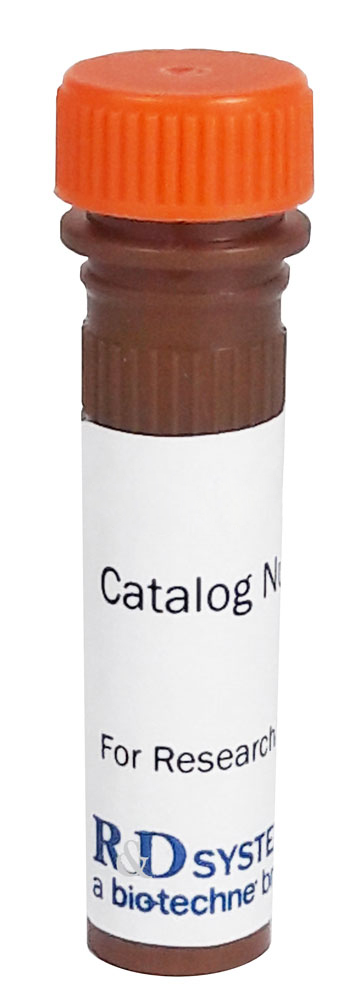Human Cadherin-12 Alexa Fluor® 594-conjugated Antibody
Human Cadherin-12 Alexa Fluor® 594-conjugated Antibody Summary
Met1-Pro609
Accession # P55289
Applications
Human neural progenitor cells differentiated by growth factor withdrawal
Note: Since classic Cadherins can be protected from trypsin treatment in the presence of Ca2+, cells in monolayer cultures are harvested with 0.01% Trypsin in the presence of 1-5 mM CaCl2 at 37° C. Flow cytometry can be performed according to the standard procedures, except that all the cell staining and washing steps are performed in the presence of Ca2+ and Mg2+ (e.g. using FACS buffer: PBS containing 1 mM CaCl2, 1 mM MgCl2, 2% FBS and 0.02% sodium azide).
Please Note: Optimal dilutions should be determined by each laboratory for each application. General Protocols are available in the Technical Information section on our website.
Reconstitution Calculator
Preparation and Storage
Background: Cadherin-12
The cadherin superfamily is a large family of membrane-associated glycoproteins that engage in homotypic, calcium-dependent, cell-cell adhesion events. The superfamily can be divided into at least four subfamilies based on its member’s extracellular (EC) regions and cytoplasmic domains (1, 2). These include classical cadherins, desmosomal cadherins, protocadherins, and cadherin-like molecules that contain a variable number of EC and transmembrane (TM) domains (1).
Cadherin‑12, also known as brain-cadherin and N-cadherin 2, is a 150 kDa classical cadherin. Classical family molecules are modular in their extracellular region, mediating calcium-dependent cell-cell adhesion through their five EC Ca++-binding repeats (2). Cadherin-12 can be further identified as a type II classical cadherin, due to the absence of a His-Ala-Val motif in its most N-terminal cadherin repeat (3). Human Cadherin-12 is synthesized as a 794 amino acid (aa) type I transmembrane preproprotein that contains a 23 aa signal peptide, a 31 aa prosequence, a 555 aa extracellular region, a 28 aa transmembrane segment, and a 157 aa cytoplasmic domain (4, 5). The five EC cadherin domains are approximately 110 aa in length and generate two beta -sheets that are oriented like bread in a sandwich. Human Cadherin-12 EC region is 96% aa identical to mouse Cadherin-12 EC region. Cadherin-12 is expressed specifically in CNS neurons. The bulk of its expression is postnatal, and it is proposed to be involved in synaptogenesis (4). As a classic cadherin, Cadherin-12 will form homodimers and promote intercellular adhesion with itself and, possibly, cadherins-8 and -14 (6).
- Koch, A.W. et al. (2004) Cell. Mol. Life Sci. 61:1884.
- Angst, B.D. et al. (2001) J. Cell Sci. 114:629.
- Gessner, R. and R. Tauber (2000) Ann. N.Y. Acad. Sci. 915:136.
- Selig, S. et al. (1997) Proc. Natl. Acad. Sci. USA 94:2398.
- Tanihara, H. et al. (1994) Cell Adhes. Commun. 2:15.
- Shimoyama, Y. et al. (2000) Biochem. J. 349:159.
Product Datasheets
Product Specific Notices
This product is provided under an agreement between Life Technologies Corporation and R&D Systems, Inc, and the manufacture, use, sale or import of this product is subject to one or more US patents and corresponding non-US equivalents, owned by Life Technologies Corporation and its affiliates. The purchase of this product conveys to the buyer the non-transferable right to use the purchased amount of the product and components of the product only in research conducted by the buyer (whether the buyer is an academic or for-profit entity). The sale of this product is expressly conditioned on the buyer not using the product or its components (1) in manufacturing; (2) to provide a service, information, or data to an unaffiliated third party for payment; (3) for therapeutic, diagnostic or prophylactic purposes; (4) to resell, sell, or otherwise transfer this product or its components to any third party, or for any other commercial purpose. Life Technologies Corporation will not assert a claim against the buyer of the infringement of the above patents based on the manufacture, use or sale of a commercial product developed in research by the buyer in which this product or its components was employed, provided that neither this product nor any of its components was used in the manufacture of such product. For information on purchasing a license to this product for purposes other than research, contact Life Technologies Corporation, Cell Analysis Business Unit, Business Development, 29851 Willow Creek Road, Eugene, OR 97402, Tel: (541) 465-8300. Fax: (541) 335-0354.
FAQs
-
Why does the staining protocol with this Cadherin antibody use buffers containing Ca2+ and Mg2+?
The staining protocol with this and other Cadherin antibodies uses buffer containing Ca2+ and Mg2+ because Cadherin function is Calcium-dependent.
Reviews for Human Cadherin-12 Alexa Fluor® 594-conjugated Antibody
There are currently no reviews for this product. Be the first to review Human Cadherin-12 Alexa Fluor® 594-conjugated Antibody and earn rewards!
Have you used Human Cadherin-12 Alexa Fluor® 594-conjugated Antibody?
Submit a review and receive an Amazon gift card.
$25/€18/£15/$25CAN/¥75 Yuan/¥2500 Yen for a review with an image
$10/€7/£6/$10 CAD/¥70 Yuan/¥1110 Yen for a review without an image

